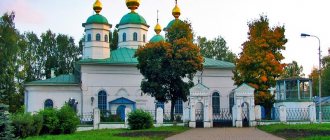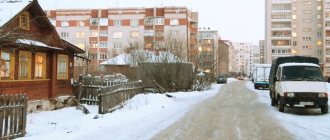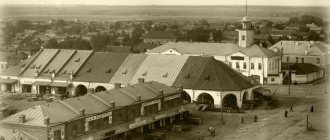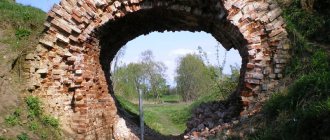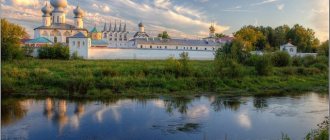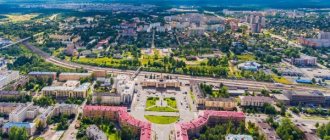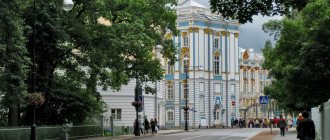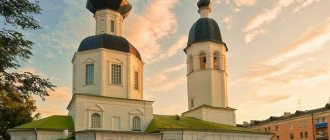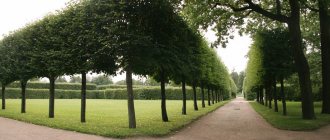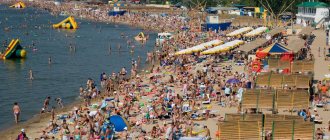Cherepovets district is the second most important district, and Cherepovets itself is the second most populous city in the Vologda region. The city is located 126 kilometers from Vologda in a place where the Yagorby River flows into the Sheksna River in close proximity to the famous Rybinsk Reservoir.
By order of the Government No. 1398-r, Cherepovets was included in the list of cities with a difficult socio-economic situation, and this situation is caused, among other things, by problems that exist in the work of city-forming enterprises.
Cherepovets has an advantageous geographical location; three transport arteries of national importance pass through its territory, namely, the highway from Vologda to Novaya Ladoga, the Northern Railway and the Mariinsky Waterway (one of the ports of this system is located in Cherepovets).
A few facts about Cherepovets
- The foundation of Cherepovets is considered to be the time of construction of the Resurrection Monastery - 1362.
- It received the status of a district town in the fall of 1777, initially entering the Novgorod province.
- Population is about 319 thousand people. Cherepovets is the largest city in the Vologda region.
- The distance along the highway to Moscow is 491 km, to Vologda – 145 km, to the homeland of Father Frost, Veliky Ustyug – 580 km.
- Cherepovets is the largest industrial center in Russia. Here is the Cherepovets Metallurgical Plant "Severstal" - the world's largest steel production plant.
Sights of Cherepovets
It is better to start viewing the sights of Cherepovets from the Cathedral Hill, located on the banks of the Yagorba River, where it flows into the Sheksna. Here is the preserved temple of the ancient Resurrection Monastery, the Resurrection Cathedral, this is where the city of Cherepovets began. There is also a monument to the founders of the city, Athanasius and Theodosius.
The main street of the city begins from Cathedral Hill - Sovetsky Prospekt, formerly Voskresensky or Bolshoi Prospekt. This is the oldest street in Cherepovets, stretching parallel to the Yagorba River.
Of the temple architecture, the one-domed Church of the Nativity of Christ, similar to a ship, is interesting. The Oktyabrsky automobile cable-stayed bridge connecting the city is also interesting.
Monument to the founders of Cherepovets Afanasy and Feodosius
Address: Cherepovets, Cathedral Hill
According to local legend, the first buildings on the site of the future city were erected by two people: the Moscow merchant Theodosius and the student of Sergius of Radonezh Afanasy, nicknamed the “Iron Staff”. They became the first monks of the Resurrection Monastery, which they founded, around which the settlement began to grow, which later became the city of Cherepovets.
In 1992, a sculptural composition was installed on the Cathedral Hill, designed by a sculptor from St. Petersburg, representing two 4-meter figures of the reverend elders. This monument is now a symbol of the city.
Train Station
Railway station "Cherepovets-I" is a station of the Vologda region of the Northern Railway. Located near Station Park at st. Zavokzalnaya, 9. The railway station operates 24 hours a day. The technical break at the ticket office lasts 1 hour: from 2:30 to 3:30. The opening date of the railway station is 1905. In 2004, a large-scale reconstruction of the station was carried out. The number of platforms is 3, the number of tracks is 18.
Popular long-distance train routes: St. Petersburg, Arkhangelsk, Yekaterinburg, Mikun, Tyumen, Kirov, Moscow, Vologda. In the summer, routes are operated to Chelyabinsk, Anapa and Adler.
Also in Cherepovets there is the Cherepovets-II railway station, which serves commuter trains. The railway station operates 24 hours a day.
Resurrection Cathedral
Address: Cathedral Hill, building 1.
The Resurrection Cathedral stands on Cathedral Hill, in a very attractive place in the city. It was from here that the beginning of both the Resurrection Monastery, which previously belonged to the mentioned temple, and the settlement, which in the future became a city, began.
Due to fires that regularly destroyed the wooden buildings of the monastery, in 1732 they decided to build a stone church, which was later transformed into the Resurrection Cathedral. The construction of the building took over 20 years. At first the structure had a simple cubic shape, but thanks to subsequent extensions it acquired its current appearance.
As for the Resurrection Monastery, it was abolished by Catherine II in 1764, and all its property, lands and peasants were transferred to the treasury.
Housing cost
As in many other cities, the cost of housing depends on many factors, including the area of the city, the number of floors of the building, the type of house, the material used for construction, etc.
On average, the cost of housing was distributed as follows:
- a studio apartment can be purchased for 1385.8 thousand;
- one-room for 1582.1 thousand;
- two-room for 2141.9 thousand;
- three-room apartment for 2824.8 thousand;
- four-room apartment for 3629.4 thousand.
The price per square meter largely depends on the number of rooms in the apartment: the fewer rooms, the more expensive the square meter costs:
- for a studio apartment 42.0 thousand;
- for a one-room apartment 42.3 thousand;
- for a two-room apartment - 40.3 thousand;
- for a three-room apartment 39.6 thousand;
- the four-room apartment has 39.5 thousand.
Depending on the area of the city, prices per square meter were distributed as follows:
- Northern region 38.4 thousand per square meter;
- Industrial 38.9 thousand;
- Zayagorbsky -40.7 thousand;
- Zarechensky -41.6 thousand;
- Zasheksninsky 41.8 thousand.
House-Museum of Milyutin
Website: museums/muzey-milyutina Address: Cherepovets, Revolution Square, building 1. Cost: 120 rubles, 60 rubles. - discount ticket.
When listing the sights of Cherepovets, one cannot pass by the house-museum of the legendary head of the city, Ivan Andreevich Milyutin, who served in this position for 46 years from 1861 to 1907. It is a modest 2-story mansion located near the Resurrection Cathedral.
Ivan Andreevich was a rare example for Russia of a combination of serious wealth, charity and a government official with an unblemished reputation. It was thanks to him that Cherepovets turned into a major center of industry and culture. He created educational institutions, banks, developed trade and transport of the city. In Cherepovets there is Milyutin Square, where a monument to him is erected.
Among the exhibits of the Milyutin Museum are thousands of household items and clothing, paintings, photographs of the corresponding period.
Church of the Nativity
Address: Cherepovets, st. Parkovaya, house 1.
One of the buildings, representing the significant sights of Cherepovets, can be seen approaching the city along the Sheksna River. This is the Church of the Nativity, dating back to an ancient wooden church built in the late 1500s. It was in its place that a stone structure was erected in 1789, which has never been reconstructed.
Until the early 1930s, the temple was operational, but then it was closed, and various economic organizations alternately operated in the premises. Such an irresponsible attitude towards an ancient building could not but lead to tragedy, and it happened. In 1989, a fire broke out inside the church, destroying all the wooden structures. However, thanks to the drawings that were found in the archives, 8 years later the temple was restored and re-consecrated.
Temple of Athanasius and Theodosius of Cherepovets
Address: Cherepovets, Makarinskaya Roshcha, building 1.
The Church of St. Athanasius and Theodosius of Cherepovets is the newest in Cherepovets and the third most important for the townspeople. Dedicated to two holy elders who founded the Resurrection Monastery, around which Cherepovets proper subsequently arose.
The construction of this temple began in 2006 thanks to the initiative of local residents. The foundation stone was laid in 2009, and construction ended 3 years later.
The temple is a tall 35-meter building of classical church architecture. It has 5 domes topped with crosses, the heaviest of which weighs 750 kg and measures 6 meters, as well as a bell tower with 12 bells.
Population
According to the latest data, 318,107 people live in Cherepovets. Moreover, over the period of observation of the population since 1856, it can be said that the number of city residents is growing year by year. The exceptions were 2001-2002, 2004-2007, when there was a slight decrease in the city's population.
A sharp increase in Cherepovka residents (8 times) was noted in the 50-60s of the last century, which is associated with the construction of new industrial enterprises in the city. People came to Cherepovets from nearby villages and small settlements in Vologda and neighboring regions in search of work and a better life.
The city's population continues to grow primarily due to migration. In Cherepovets you can find high-paying jobs; the city has a developed infrastructure.
In the structure of the national composition of Cherepovets, 94% belong to Russians.
Monument to metallurgists
On Metallurgists Square there is a Monument to Metallurgists, showing the continuity of the working dynasties of Cherepovets. The sculptural composition consists of a sitting metallurgist father and a child in a helmet walking towards a bright future. Behind them is a 10-meter stele, symbolizing fire and steel with the inscription: “Dedicated to Cherepovets metallurgists.”
From Metallurgiv Square there is Metallurgiv Street, which stretches to the Metallurgical Plant.
Vereshchagin House-Museum
Website: memorialnyj-dom-muzej-vereshchaginykh Address: Socialisticheskaya st., building 22. Ticket price: 120 rubles, reduced price 80 rubles.
In Cherepovets there is a building that is directly related to the great Russian battle painter Vasily Vereshchagin. This is his family estate, where the master was born in 1842, and then visited him regularly. The estate belonged to the Vereshchagin family for almost half a century.
After the October Revolution of 1917, the building located here was converted into a residential communal building, which it remained in until 1984. However, this did not stop the local authorities from initiating the collection of a collection dedicated to the great artist. The first exhibits were received as a gift from one of Vereshchagin’s descendants back in 1927.
In 1960, the artist’s house was recognized as a monument of federal significance, and since 1984 a full-fledged museum opened in it. In 1992 it was expanded and now consists of 2 buildings: the Memorial House and the House of Creativity. Here you can find mostly reproductions of Vereshchagin’s paintings and photographs. But there are other documents telling about the artist’s relatives, in particular, about his brother Nikolai, who became a famous cheese maker in Russia.
CHEREPOVETS
CHEREPOVETS, a city in Russia, in the Vologda region, the center of the city district of the same name and the Cherepovets municipal district. Us. 314.8 thousand people (2019), the largest city in the region by population. Located at the confluence of the river. Yagorba in the river Sheksna (port). Railway station. The Vologda – Novaya Ladoga highway passes near Ch. Intl. airport (25 km from Ch.).
Story
It emerged as a sub-monastery settlement of the Voskresensky Cherepovsky Monastery. (founded probably between 1355 and 1364; mentioned since 1449, abolished in 1764). Near the monastery by the 16th century. a large village was formed. Fedosyevo. In 1610, 1613 and 1618 the monastery and its surroundings were devastated by the Polish-Litovs. in squads. As a result of secularization in 1764, the monastery was abolished, and the settlement came under the jurisdiction of the College of Economy. In 1777, by uniting the monastery settlement and the village. Fedosyevo was formed as a town. Uezdny (1780–96, 1802–1918) and a provincial town (1796–1802) in the Novgorod province (until 1796 – Novgorod governorship). In 1796–1802, as part of the Ustyuzhensky district of the Novgorod province. One of the chapters ports on the Mariinskaya water system (opened in 1810). In 1906, traffic was opened along the railway that passed through Ch. line Obukhovo (St. Petersburg) - Vologda. Sov. power was established on October 27 (11/9). 1917. In 1918–27 adm. center of Cherepovets province. District (1927–30) and regional center of the Leningrad region (1927–37), since 1937 regional center of the Vologda region, a city of regional subordination. During the Great Patriotic War, St. 10 evacuation hospitals. In 1948–55 in the west. On the outskirts of the city a large metallurgical plant was built. plant (now Severstal). Since 2004, the center of the city district of the same name and the Cherepovets municipal district.
Architecture
Cherepovets. The main house of the Galsky estate is Gorka. 1st half of the 19th century
In the end 18 – 1st quarter. 20th centuries developed on the right bank of the Sheksna according to the plan of 1782. The 5-domed, 4-pillar Resurrection Cathedral (1752–56, rebuilt in the 19th century) was preserved. Voskresensky Cherepovsky mon., ts. Nativity of Christ (1789, restored in 1992–96), 2-story merchant houses. houses of the 19th century, a women's gymnasium (1876), the chapel of St. Philip of Irapa (early 1880s), 3 buildings of shopping arcades (1890, 1909, 1911–13), railway. station (1904–05), cinema "Royal-Vio" (1910), Chamber Theater (1914–16), wooden. residential buildings. On the left bank of the Sheksna is the Galsky estate - Gorka (1st half of the 19th century, museum since 1989). Near metallurgical plant, new areas were built according to the regular layout of 1950 (architect A.A. Ol): Palace of Culture of the Builders (1954), cinema (1958, architect I.V. Zholtovsky), Gor. Palace of Culture (1992), Palace of Metallurgists (1993), Cathedral of Saints Athanasius and Theodosius of Cherepovets (2009–2014). Monument to V.V. Vereshchagin (1957, project by architect A.V. Gulyaev, sculptors B.V. Edunov, A.M. Portyanko).
Centers of science and culture
Research Institute for Fertilizers and Insectofungicides named after. Professor Ya. V. Samoilov (1919). Cherepovets State University (founded in 1996 on the basis of industrial and pedagogical institutes). Higher military Engineering School of Radioelectronics (dates back to 1957).
The Museum Association (1988) includes museums: historical and local history. (1895, opened in 1896), nature (1920), art. (1938), memorial House-Museum of the Vereshchagins (1984), children's (history dates back to 1988, established in 2001), “Galsky Estate” (founded in 1989; estate complex of the 1st third of the 19th century), archeology, “House of I A. Milyutin" (2006), as well as an exhibition hall (1980). Chamber Theater (1993; dates back to the 1860s), dance and pantomime theater "Trans-Theater" (founded in 1993).
In the vicinity of Ch., in the village. Vladimirovka, - Lit. I. Severyanin Museum (1996, branch of the museum association; in the Lotarevs’ estate, where the poet visited several times in the late 19th – early 20th centuries).
Sport
Hockey club "Severstal" (founded in 1955); plays in the Kontinental Hockey League; silver (2003) and bronze medalist (2001) of the Russian Championship; hosts rivals at the Ice Palace (opened in 2006; 5.7 thousand seats). Severstal's farm club (reserve team) - Almaz (founded in 2009) - has been playing in the Youth Hockey League championship since the 2009/10 season (and for the 2020/21 season). The city's largest stadium, Metallurg, can accommodate up to 12 thousand spectators.
Farm
The largest industrial center of the Vologda region The base of the mountains. economy - ferrous metallurgy, metalworking and chemicals. industry The city-forming enterprises of the city are included in the structure: Cherepovets Metallurgical. plant (1955; full-cycle enterprise, includes coke-chemical, sintering, blast furnace, steelmaking and rolling production; production of marine, electrical, double-layer clad, galvanized steel, steel for bridge construction, construction of buildings and structures, steel for pressure vessels, fittings, wire rod, sheet metal, bent profiles, pipe blanks, etc.) and the Severstal-Metiz steel rolling plant (founded in 1965 as the Cherepovets Steel Rolling Plant; calibrated steel, steel shaped profiles, nails, steel wire fiber, etc.).
Another city-forming enterprise of the city is (until 2022 - PhosAgro-Cherepovets; part of one of the world's leading producers of phosphorus-containing fertilizers; production of phosphorus-containing fertilizers, phosphoric and sulfuric acids, NPK fertilizers, ammonia and ammonium nitrate; export of products).
Among the leading enterprises: mechanical engineering (2002; in the structure; mining, sintering, coke, blast furnace, steelmaking, rolling, warehouse, lifting and transport equipment, forged and stamped products, metal structures, casting, etc.), Cherepovets Foundry and Mechanical Plant (1950 ; tractors and agricultural special equipment, equipment parts for metallurgy, mechanical engineering, chemical and mining industries), "Severstal lifting technologies" (2009; steel ropes, slings, lifting components), "UniSpring" (formed in 1997 as a joint venture of the Cherepovets steel-rolling plant; mattresses , spring blocks for upholstered furniture and mattresses), UniFens (grids and mesh structures; all three are included), Ultracraft (2010; automated complexes for ultrasonic testing of continuously cast billets, sheet and long products, pipes, autonomous automated complexes ultrasonic testing of pipes in the field on existing pipelines, process automation systems, automated complexes for ultrasonic testing of railway tracks, etc.).
Operating: Cherepovets Welding Materials Plant (founded in 1966, current status since 2012; production of welding wire), (1973; enameled and non-stick cookware), Cherepovets Plywood and Furniture Plant (plywood, lumber, chipboard, chipboard, fiberboard), clothing factory "Astrol" (men's and women's clothing), food industry enterprises (Cherepovets meat-packing plant, etc.) and construction materials production (Cherepovets silicate brick plant, "Reinforced concrete products base" and "Reinforced concrete products and structures plant").
Museum of the Metallurgical Industry
Website: museummet.ru Address: Cherepovets, st. Mira, house 42.
This establishment was created at the request of metallurgical veterans. The initiative of the old workers was supported by the management of the enterprise, taking the future museum on its balance sheet. The idea of the veterans was to create not a simple monument to metallurgists, but a kind of center where local residents and tourists could come.
The result of the plant’s efforts was a two-story building, in which, along with traditional metallurgy exhibitions, there is a career guidance center, laboratories for conducting chemical and physical experiments, as well as rooms for master classes and quests.
Using modern equipment, the conditions that exist in the workshops are recreated here; using 3D glasses, you can see a 3-dimensional image of the plant with all its workshops.
Popular message topics
- Herpes virus
The herpes virus is one of the types of large families of viruses that affects not only people, but also animals. A person whose body has entered this virus becomes its permanent carrier, since it is not possible to get rid of it. - Bears
Everyone knows that bears are predatory animals. Bears are capable of fast movement, both on land and in water - this allows them to calmly get food, and the ability to climb makes it easier to catch animals that huddle in trees. - Life of the forest
Many people think that a forest is just a lot of different trees and animals living in it, but this is a mistaken opinion. Residents of the city do not know that life is in full swing in the forest and many interesting processes are happening. The forest is its own world, in which a lot happens
Galisky Estate
Website: usadba-galskikh Address : Cherepovets, Maturinskaya st., building 28.
This historical and ethnographic museum was opened relatively recently, in 2009. A beautiful building with a rich history was selected for it.
Back in the 1830s, it was built at the request of the local landowner Kudryavy as a country house. The landowner received not just a building, but a real architectural masterpiece, executed in the style of provincial classicism.
20 years later, the estate was taken over by the Galsky family of nobles, who launched active agricultural production here. Unlike many other noble estates, the revolutionaries did not destroy it, but, on the contrary, gave it a safe conduct.
For this reason, despite the fact that the building alternately housed various public organizations, the building has survived to this day almost in its original form. Now both the estate and the adjacent territory are a single architectural and landscape complex.
Construction in the city
Until the 50-60s of the last century, Cherepovets was a small city of regional significance. It was characterized by a fairly even grid of streets intersecting at right angles. Now this is the so-called old Cherepovets.
The construction of the metallurgical plant caused an influx of population from neighboring settlements into the city and the expansion of the city in the northern and western directions. New residential complexes have appeared behind Sheksnaya and behind Yagorba.
Active construction of new residential buildings continues to this day. Both new apartment buildings and entire cottage communities are being built.
Museum of Nature
Website: muzej-prirody Address : Cherepovets, prosp. Lunacharsky, 32.
In the center of Cherepovets there is an establishment that children really like. This is a nature museum. Its exhibition began to be created almost 100 years ago. Despite the regular change of names, the function of the institution remained unchanged: popularizing knowledge about local nature.
Now there is a rich collection of rocks, minerals and fossils. In total, the museum has about 30,000 exhibits, which are periodically exhibited during various exhibitions. The oldest are considered to be the fossilized remains of ancient animals, which have been collected since 1907. This collection is constantly updated thanks to reconnaissance expeditions of museum staff and active construction in the vicinity of Cherepovets.
Literary Museum
Website: literaturnyj-muzej Address: Cherepovets district, Vladimirovka village
The Literary Museum is not located in the city itself, but an hour’s drive away in the village of Vladimirovka, and occupies a rather modest house there. The building itself belonged to Igor Severyanin’s uncle Mikhail Lotarev, and was built at the turn of the century, in 1899.
The future writer often visited his uncle, but after the Bolsheviks who came to power in 1917 nationalized the estate and sold off the property, the poet left Russia. Subsequently, the house was transferred to a sanatorium, but even before its closure, space was allocated there for an exhibition dedicated to the work of Severyanin.
At the moment, the estate in Vladimirovka is the only museum in Russia dedicated to the life and work of this extraordinary poet.
Economy
Cherepovets is a city of industrial enterprises. The leading sectors of the economy are ferrous metallurgy and the chemical industry. Enterprises in this sector employ about 40% of the total working population.
The city has developed light and food industries, woodworking, metalworking and construction industries. However, the industrial potential of the entire city is formed, first of all, by such organizations as Severstal, the steel rolling plant and PhosAgro-Cherepovets.
It is in Cherepovets that such an indicator as GDP per capita is 2 times higher than the similar indicator of other Russian cities.
As for the fuel and energy complex, the leading place here belongs to the energy sector. Half of all electricity consumed by the city is imported from neighboring regions.
